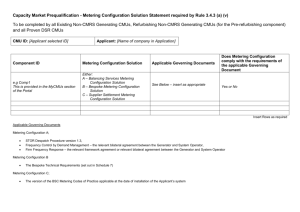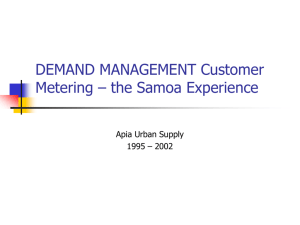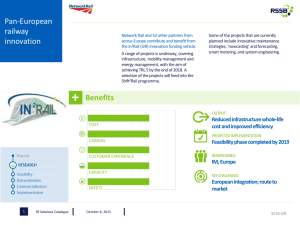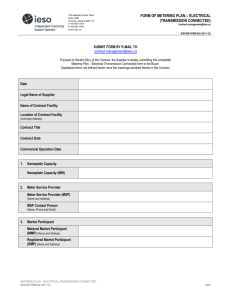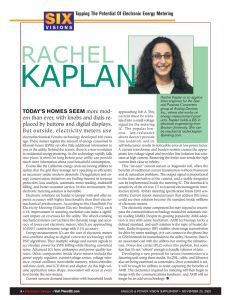Case Study: Pacific Gas and Electric Company’s
advertisement
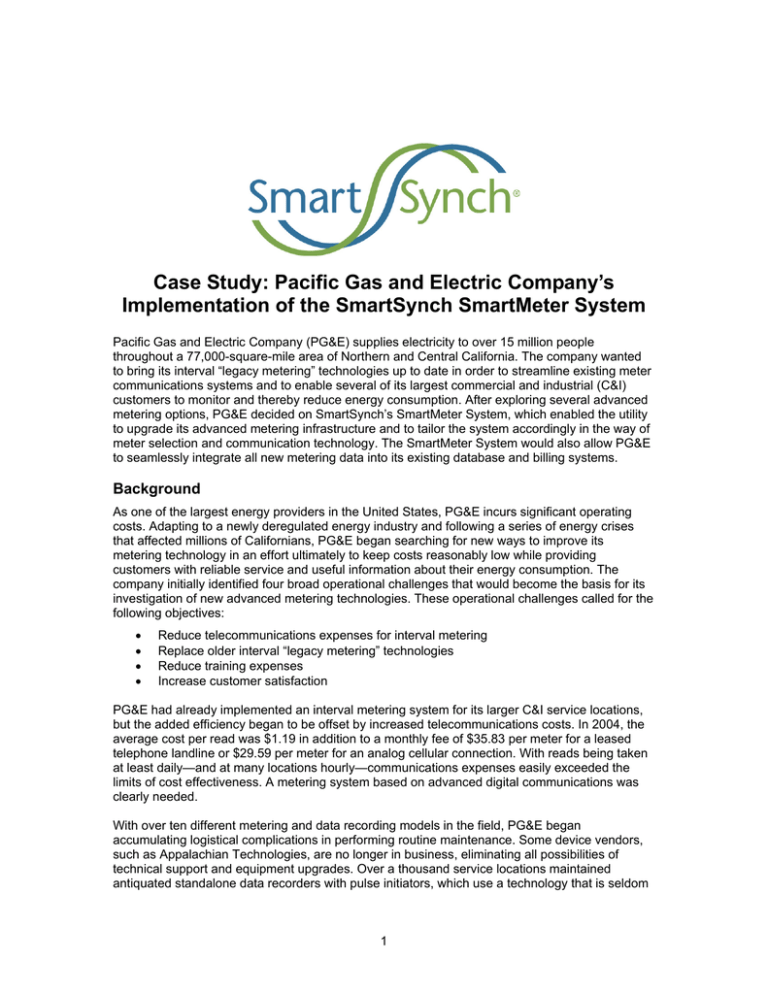
Case Study: Pacific Gas and Electric Company’s Implementation of the SmartSynch SmartMeter System Pacific Gas and Electric Company (PG&E) supplies electricity to over 15 million people throughout a 77,000-square-mile area of Northern and Central California. The company wanted to bring its interval “legacy metering” technologies up to date in order to streamline existing meter communications systems and to enable several of its largest commercial and industrial (C&I) customers to monitor and thereby reduce energy consumption. After exploring several advanced metering options, PG&E decided on SmartSynch’s SmartMeter System, which enabled the utility to upgrade its advanced metering infrastructure and to tailor the system accordingly in the way of meter selection and communication technology. The SmartMeter System would also allow PG&E to seamlessly integrate all new metering data into its existing database and billing systems. Background As one of the largest energy providers in the United States, PG&E incurs significant operating costs. Adapting to a newly deregulated energy industry and following a series of energy crises that affected millions of Californians, PG&E began searching for new ways to improve its metering technology in an effort ultimately to keep costs reasonably low while providing customers with reliable service and useful information about their energy consumption. The company initially identified four broad operational challenges that would become the basis for its investigation of new advanced metering technologies. These operational challenges called for the following objectives: • • • • Reduce telecommunications expenses for interval metering Replace older interval “legacy metering” technologies Reduce training expenses Increase customer satisfaction PG&E had already implemented an interval metering system for its larger C&I service locations, but the added efficiency began to be offset by increased telecommunications costs. In 2004, the average cost per read was $1.19 in addition to a monthly fee of $35.83 per meter for a leased telephone landline or $29.59 per meter for an analog cellular connection. With reads being taken at least daily—and at many locations hourly—communications expenses easily exceeded the limits of cost effectiveness. A metering system based on advanced digital communications was clearly needed. With over ten different metering and data recording models in the field, PG&E began accumulating logistical complications in performing routine maintenance. Some device vendors, such as Appalachian Technologies, are no longer in business, eliminating all possibilities of technical support and equipment upgrades. Over a thousand service locations maintained antiquated standalone data recorders with pulse initiators, which use a technology that is seldom 1 supported by modern data-acquisition systems. These systems used data-storage devices that used paper tapes, strip charts, magnetic tape recorders, and other storage media that are now considered obsolete. Too many different types of models and configurations rendered training for new utility employees time consuming, complex, and expensive. PG&E needed metering personnel to address problems quickly and hoped to implement a training program that would take qualified engineers and technicians a relatively short period of time to complete. The new metering and communications technologies also require technical personnel to be knowledgeable in multiple areas, including computer hardware and software, telecommunications, and utility business processes. A homogenous and complete metering system would offer PG&E technicians a more amenable method of becoming familiar with comprehensive metering solutions, providing them with a broader knowledge of the overall system. Many of PG&E’s customers were dissatisfied with the appearance of the patchwork of legacy metering components on the sides of their buildings. Many locations contained several components that were pieced together over the course of many years. The aesthetics of such a conglomeration—consisting of meters, recorders, telecommunications devices, antennas, and wiring—left much to be desired. Research PG&E knew that their future as leading utility depended on the advanced metering system that they chose to implement. Two options were apparent: replace leased-line and analog cellular with digital cellular or replace the “legacy” systems with a different technology. While upgrading the existing cellular technology would initially be less expensive and would address the phasing out of analog cellular service, the reality was that external digital cell phone modules cost as much as or more than the interval meters themselves and do not address the metering “footprint” issue. Despite initial investment costs, upgrading the metering system by replacing it with a newer, more comprehensive solution was clearly preferable and, in the long term, more efficient, reliable, and cost-effective. 2 After an extensive review of several advanced metering solutions, PG&E discovered that SmartSynch’s SmartMeter System would meet and exceed the requirements established during the preliminary review of a new metering initiative. The GPRS and ReFLEX communications functionality of the SmartMeters would offer the utility a cost-effective advantage over leased-line and traditional cellular communications systems. These newer communications technologies were becoming more widespread as the older systems were on the decline. In addition, service fees for using these public wireless networks were becoming less expensive, bringing meterreading expenses to an all-time low. In addition, with the growing proliferation of the new digital wireless networks, placing SmartMeters in outlying or hard-to-reach locations was a much more feasible option. With a choice of network systems, installing an advanced meter at any given location was much more of a possibility than ever before. Results The SmartMeter System integrates easily with PG&E’s legacy information systems, including the existing Itron MV-90 system. The data supplied by TMS also interfaces seamlessly with the utility’s Microsoft SQL server, which allows for easy data access and custom reporting. PG&E has received excellent service and support from SmartSynch and plans to increase its number of deployed SmartMeters over the next several years. Over one third of PG&E’s C&I installed meter base consists of SmartSynch SmartMeters. At the end of 2005, the average cost per read for electric interval metering had decreased to eighty-five cents per read. With additional advanced meters throughout the C&I account base, it is expected that this average will decrease to fifty cents per read within a short period of time. PG&E is beginning to replace its obsolete interval recorder equipment with advanced meters and attendant communications and head-end systems. 3

